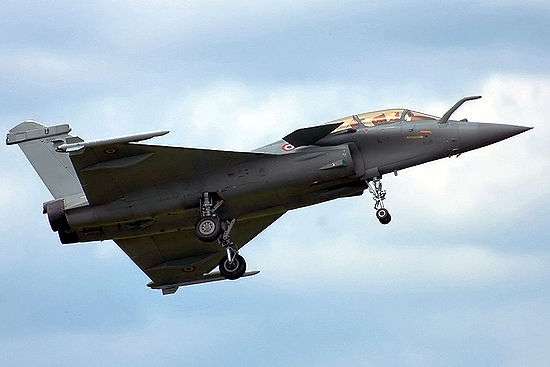 French Dassault Rafale |
Although the IAF planned to finish the trials by March in the world's most hotly contested aircraft deals this century yet, they could actually go on till August next year as some of the manufacturers say that they would be able to send their aircraft to India only around September. That means that the hot weather trials due to be held in Jaisalmer in Indian desert conditions would be completed not in July 2009 but in July 2010.
Letters of invitation for the flight trials have been issued to all the six manufacturers in fray, including the French Rafale, which was on the verge of being out of competition simply for not answering all the queries set out in the Request for Proposals (RfP), or the tender.
But the IAF Chief of Air Staff, Air Chief Marshal P.V. Naik, confirmed that Rafale was very much in the competition, pointing out that the "template for flight tests would be common to all".
The Air Chief, who released the June edition of India Strategic defence magazine at the Paris Air Show this week, said in an interview that the schedule would indeed be tight, beginning with aircraft and systems checks and humid condition trials in Bangalore. From there the aircraft would be moved to Jaisalmer for hot weather checks and then to Leh for cold weather and heights trials.
The six aircraft in the $ 10 to 15 billion competition are the French Dassault Rafale, European Consortium EADS' Eurofighter, US Lockheed Martin's F-16 Viper and Boeing's F-18 Super Hornet, Swedish Gripen and the Russian MiG-35.
According to the interview report in India Strategic, IAF is deploying two to three teams from its elite Bangalore-based Aircraft and Systems Testing Establishment (ASTE) for the trials.
Assisted by HAL and other experts, the test pilots will initially visit the manufacturing facilities to familiarize themselves with procedures and operations of the six aircraft.
"The evaluations would be in sequence, one after the other, starting from Bangalore." Air Chief Marshal Naik pointed out: "In India, the aircraft would be subjected to performance trials which would include takeoff and landing characteristics, aircraft manoeuvering, and checks of certain systems in the air. Evaluation of its maintainability, mission support equipment, operations at high altitude and in specific environments will also be conducted. Analyses of some aspects operations of its avionics, radar and Electronic Warfare (EW) systems along with live firing of long range weapons would be conducted at vendor-specific locations."
All the trials are on No-Cost-No-Commitment basis, and the IAF will buy only one aircraft which meets all the parameters in terms of capabilities and cost.
He observed that this was the first time that field trials of multiple aircraft under a single RfP were being undertaken. Live firing, maintainability, and environmental tests would be part of the testing. "The magnitude of the task is enormous and time lines are critical. Considering the complexity of trials, the evaluation will be split and each sub-team will evaluate a set of aircraft each, though under a common team leader."
Each manufacturer should bring at least two aircraft to India, and while one aircraft could be tested in Bangalore, the other could move on to Jaisalmer and Leh. Some of the missile firing and Electronic Warfare (EW) tests would be held in the country of manufacture.
Although the tender is for 126 aircraft, there is an option for an additional 50 percent, or 63 more aircraft.
IAF combat squadrons have been depleting in numbers as no new aircraft have been acquired since the 1980s - except for SU-30s - and according to Air Chief Marshal Naik, the IAF could exercise the option but "the acquisition of more aircraft would be assessed at an appropriate time, based on our experience and requirement".
IAF was hopeful to get the first selected aircraft by 2013-14. After the IAF submits its choice of one or more aircraft to the MoD, the latter would take a decision on the final selection, and its manufacturer would begin supplying the aircraft within three years of the signing of the contract, said Naik.
The initial value for 126 aircraft with two years of spares and maintenance is estimated at around USD 10 billion. It would be the responsibility of the manufacturer to ensure periodic upgrades and serviceability for up to 40 years. For that, additional life cycle costs would be examined, and the Department of Defence Finance would play a crucial role in this regard.
Notably, some aircraft are cheaper to buy but more expensive to maintain. And some may not meet the requirement for periodic cutting edge technology upgrades, that would be essential to fly the aircraft for up to 40 years as per the RfP.
Asked how would the IAF evaluate the AESA (Active Electronically Scanned Array) requirement that is mandatory but not yet available on board some of the aircraft, the Air Chief said that the trial template is common for all, without deviation, and to be selected, an aircraft would have to meet the requirements in the RfP.
AESA can greatly help a pilot in locating and neutralizing a threat far away from itself to ensure the First Kill probability with long-range Beyond-the-Visual-Range (BVR) missiles. There is, incidentally, no silver medal in a combat.






